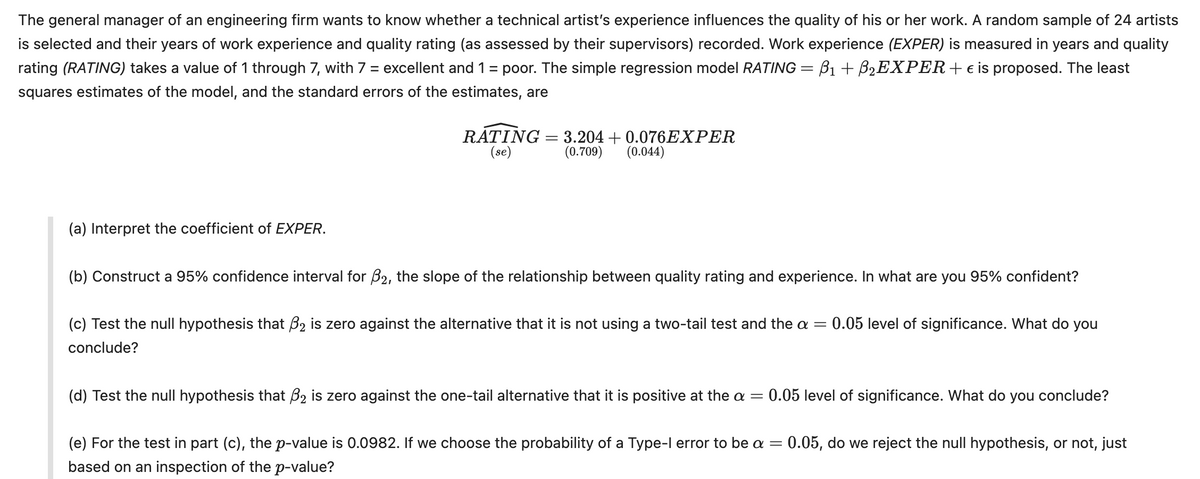The general manager of an engineering firm wants to know whether a technical artist's experience influences the quality of his or her work. A random sample of 24 artists is selected and their years of work experience and quality rating (as assessed by their supervisors) recorded. Work experience (EXPER) is measured in years and quality rating (RATING) takes a value of 1 through 7, with 7 = excellent and 1 = poor. The simple regression model RATING = ẞ1 + ẞ₂EXPER+ € is proposed. The least squares estimates of the model, and the standard errors of the estimates, are RATING= 3.204 +0.076EXPER (se) (0.709) (0.044) (a) Interpret the coefficient of EXPER. (b) Construct a 95% confidence interval for B2, the slope of the relationship between quality rating and experience. In what are you 95% confident? (c) Test the null hypothesis that ẞ2 is zero against the alternative that it is not using a two-tail test and the α = 0.05 level of significance. What do you conclude? (d) Test the null hypothesis that ẞ2 is zero against the one-tail alternative that it is positive at the a = €0.05 level of significance. What do you conclude? (e) For the test in part (c), the p-value is 0.0982. If we choose the probability of a Type-I error to be a = 0.05, do we reject the null hypothesis, or not, just based on an inspection of the p-value?
The general manager of an engineering firm wants to know whether a technical artist's experience influences the quality of his or her work. A random sample of 24 artists is selected and their years of work experience and quality rating (as assessed by their supervisors) recorded. Work experience (EXPER) is measured in years and quality rating (RATING) takes a value of 1 through 7, with 7 = excellent and 1 = poor. The simple regression model RATING = ẞ1 + ẞ₂EXPER+ € is proposed. The least squares estimates of the model, and the standard errors of the estimates, are RATING= 3.204 +0.076EXPER (se) (0.709) (0.044) (a) Interpret the coefficient of EXPER. (b) Construct a 95% confidence interval for B2, the slope of the relationship between quality rating and experience. In what are you 95% confident? (c) Test the null hypothesis that ẞ2 is zero against the alternative that it is not using a two-tail test and the α = 0.05 level of significance. What do you conclude? (d) Test the null hypothesis that ẞ2 is zero against the one-tail alternative that it is positive at the a = €0.05 level of significance. What do you conclude? (e) For the test in part (c), the p-value is 0.0982. If we choose the probability of a Type-I error to be a = 0.05, do we reject the null hypothesis, or not, just based on an inspection of the p-value?
Functions and Change: A Modeling Approach to College Algebra (MindTap Course List)
6th Edition
ISBN:9781337111348
Author:Bruce Crauder, Benny Evans, Alan Noell
Publisher:Bruce Crauder, Benny Evans, Alan Noell
Chapter3: Straight Lines And Linear Functions
Section3.CR: Chapter Review Exercises
Problem 15CR: Life Expectancy The following table shows the average life expectancy, in years, of a child born in...
Related questions
Question

Transcribed Image Text:The general manager of an engineering firm wants to know whether a technical artist's experience influences the quality of his or her work. A random sample of 24 artists
is selected and their years of work experience and quality rating (as assessed by their supervisors) recorded. Work experience (EXPER) is measured in years and quality
rating (RATING) takes a value of 1 through 7, with 7 = excellent and 1 = poor. The simple regression model RATING = ẞ1 + ẞ₂EXPER+ € is proposed. The least
squares estimates of the model, and the standard errors of the estimates, are
RATING= 3.204 +0.076EXPER
(se)
(0.709) (0.044)
(a) Interpret the coefficient of EXPER.
(b) Construct a 95% confidence interval for B2, the slope of the relationship between quality rating and experience. In what are you 95% confident?
(c) Test the null hypothesis that ẞ2 is zero against the alternative that it is not using a two-tail test and the α = 0.05 level of significance. What do you
conclude?
(d) Test the null hypothesis that ẞ2 is zero against the one-tail alternative that it is positive at the a = €0.05 level of significance. What do you conclude?
(e) For the test in part (c), the p-value is 0.0982. If we choose the probability of a Type-I error to be a = 0.05, do we reject the null hypothesis, or not, just
based on an inspection of the p-value?
Expert Solution
This question has been solved!
Explore an expertly crafted, step-by-step solution for a thorough understanding of key concepts.
This is a popular solution!
Trending now
This is a popular solution!
Step by step
Solved in 2 steps

Recommended textbooks for you

Functions and Change: A Modeling Approach to Coll…
Algebra
ISBN:
9781337111348
Author:
Bruce Crauder, Benny Evans, Alan Noell
Publisher:
Cengage Learning

Linear Algebra: A Modern Introduction
Algebra
ISBN:
9781285463247
Author:
David Poole
Publisher:
Cengage Learning


Functions and Change: A Modeling Approach to Coll…
Algebra
ISBN:
9781337111348
Author:
Bruce Crauder, Benny Evans, Alan Noell
Publisher:
Cengage Learning

Linear Algebra: A Modern Introduction
Algebra
ISBN:
9781285463247
Author:
David Poole
Publisher:
Cengage Learning


Glencoe Algebra 1, Student Edition, 9780079039897…
Algebra
ISBN:
9780079039897
Author:
Carter
Publisher:
McGraw Hill

Algebra & Trigonometry with Analytic Geometry
Algebra
ISBN:
9781133382119
Author:
Swokowski
Publisher:
Cengage

Big Ideas Math A Bridge To Success Algebra 1: Stu…
Algebra
ISBN:
9781680331141
Author:
HOUGHTON MIFFLIN HARCOURT
Publisher:
Houghton Mifflin Harcourt